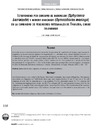Identificador persistente para citar o vincular este elemento:
https://accedacris.ulpgc.es/jspui/handle/10553/77203
| Campo DC | Valor | idioma |
|---|---|---|
| dc.contributor.author | Gaitán Espitia, Juan Diego | en_US |
| dc.date.accessioned | 2021-01-15T17:10:53Z | - |
| dc.date.available | 2021-01-15T17:10:53Z | - |
| dc.date.issued | 2007 | en_US |
| dc.identifier.issn | 1794-5992 | en_US |
| dc.identifier.other | WoS | - |
| dc.identifier.uri | https://accedacris.ulpgc.es/handle/10553/77203 | - |
| dc.description.abstract | An icthyotoxism event was studied in the Tasajera fishermen's community, department of Magdalena. The ciguatera intoxication was diagnosed to 7 individuals whose ages were ranging between 17 and 53 years (63,4 %), with symptoms of vomit (100 %), muscular pain in low members (71,4 %), abdominal spasms (85,7 %), diarrhea (100 %), numbness and tingling of face, hands, feet (85,7 %), sickness (100 %), and cutaneous outbreak (14,2 %), the symptoms in the majority of the cases disappeared in a space from 8 to 12 days. The consumption of the barracuda (Sphyraena barracuda) spotted moray (Gymnothorax moringa) meat was determined as principal source of the ciguatera event. | en_US |
| dc.description.abstract | Se estudió un evento de ictiotoxismo en la comunidad de pescadores de la población de Tasajera, departamento del Magdalena. La intoxicación por ciguatera fue diagnosticada a 7 individuos cuyas edades oscilaban entre los 17 y 53 años (63,4% de rango de edades de los pescadores del sector), con síntomas de vómito (100%), dolor muscular en miembros inferiores (71,4%), espasmos abdominales (85,7%), diarrea (100%), entumecimiento y hormigueo de cara, manos, pies (85,7%), mareo (100%), y brote cutáneo (14,2%), los síntomas en la mayoría de los casos desaparecieron en un lapso de 8 a 12 días. Se determinó como causa principal del evento de ciguatera el consumo de carne de barracuda (Sphyraena barracuda) y morena (Gymnothorax moringa). | en_US |
| dc.language | spa | en_US |
| dc.relation.ispartof | Duazary | en_US |
| dc.source | Duazary [ISSN 1794-5992], v. 4 (2), p. 160-167, (Julio-Diciembre 2007) | en_US |
| dc.subject | 310907 Patología | en_US |
| dc.subject.other | Icthyotoxism | en_US |
| dc.subject.other | Ciguatera | en_US |
| dc.subject.other | Intoxication | en_US |
| dc.subject.other | Colombian Caribbean | en_US |
| dc.subject.other | Ictiotoxismo | en_US |
| dc.title | Ictiotoxismo por consumo de barracuda (Sphyraena barracuda) y morena manchada (Gymnothorax moringa) en la comunidad de pescadores artesanales de Tasajera, caribe colombiano | en_US |
| dc.title.alternative | Ictiotoxismo Consumption by Barracuda (Sphyraena barracuda) and Spotted Moray (Gymnothorax moringa) in the fishing community of artisan Tasajera colombian caribbean | en_US |
| dc.type | info:eu-repo/semantics/Article | en_US |
| dc.type | Article | en_US |
| dc.identifier.isi | 000210111000010 | - |
| dc.identifier.eissn | 2389-783X | - |
| dc.description.lastpage | 167 | en_US |
| dc.identifier.issue | 2 | - |
| dc.description.firstpage | 160 | en_US |
| dc.relation.volume | 4 | en_US |
| dc.investigacion | Ciencias de la Salud | en_US |
| dc.type2 | Artículo | en_US |
| dc.contributor.daisngid | 25765474 | - |
| dc.description.numberofpages | 8 | en_US |
| dc.utils.revision | Sí | en_US |
| dc.contributor.wosstandard | WOS:Espitia, JDG | - |
| dc.date.coverdate | Julio-Diciembre 2007 | en_US |
| dc.identifier.ulpgc | Sí | en_US |
| dc.description.esci | ESCI | |
| dc.description.erihplus | ERIH PLUS | |
| item.grantfulltext | open | - |
| item.fulltext | Con texto completo | - |
| Colección: | Artículos | |
Citas de WEB OF SCIENCETM
Citations
1
actualizado el 25-feb-2024
Visitas
108
actualizado el 10-ago-2024
Descargas
57
actualizado el 10-ago-2024
Google ScholarTM
Verifica
Comparte
Exporta metadatos
Los elementos en ULPGC accedaCRIS están protegidos por derechos de autor con todos los derechos reservados, a menos que se indique lo contrario.
